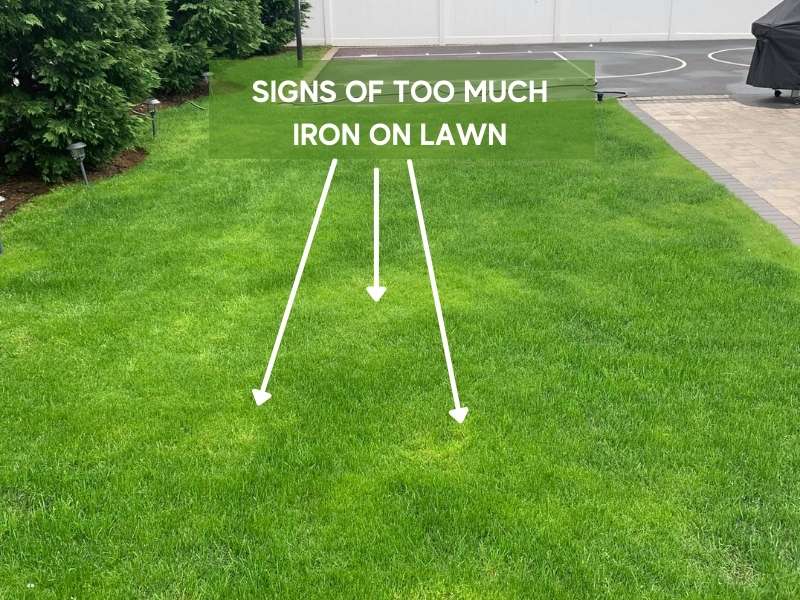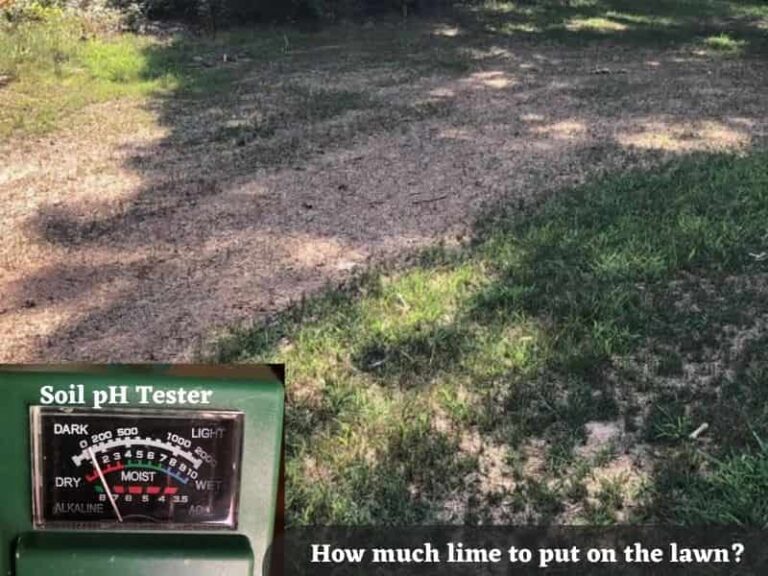Too Much Iron in Lawn: Signs and How to Fix It
Iron is a micronutrient that boosts color in lawns without increasing growth and water needs. It also controls moss. However, excessive use of iron will burn your grass’ blades and toxify the environment. If you suspect that your lawn is discolored due to too much iron, you must find out how to revive it.
Too much iron on your lawn will burn the grass, stain your pavements and decrease soil pH. If your soil pH is below 5.5, add lime, bicarbonate-based chemicals, or zinc to adjust it. After treatment, apply iron 4 times a year when temperatures fall between 40 and 80°F (spring or fall).
Contents
Can you apply too much iron on lawn?
It is possible to apply too much iron on your lawn while eliminating moss or boosting the color of your lawn. A high concentration of iron, together with factors like extreme temperatures, wet or dry soil, and grass type, will cause your lawn to burn.
Lawns require supplements like iron sulfate, which has a high nutrient and mineral concentration that catalyzes chlorophyll synthesis. Without the green-coloring matter, your grass can’t produce energy to facilitate photosynthesis.
Some fertilizer products claim that they don’t subject grass to burns, but you never know until you apply too much iron and see side effects.

Factors that influence burns in the grass due to high iron concentration include:
1. Temperatures below 55°F and above 80°F
Applying iron supplements on the grass in extreme temperatures below 55 degrees Fahrenheit or above 80 degrees Fahrenheit causes burns on your lawn. Ideally, you should aim at fertilizing it during spring when the ground temperatures are at 60 to 70 degrees Fahrenheit.
2. Wet or dry soil
Applying iron on wet soil can also cause burns in the grass. Ensure the ground moisture is balanced level (neither too dry nor wet) to allow the grass to soak up the iron.
3. Planting warm season grass in cool regions and vice versa
If you plant warm-season grass in a cooler climate, chances are your iron application method might backfire, and vice versa. Therefore, it’s best to stick to grass that suits your geographical location and climate.
There are about a dozen varieties of grass species for lawns, many of which contain a mixture of two or more varieties. They fall into two categories:
- Warm-season grasses like Bermudagrass and St. Augustine grass thrive in warmer climates like the South and Southwestern states.
- Cold-season grasses like Tall fescue and Kentucky bluegrass prefer cooler climates such as the Pacific Northwest and Northeast.
Signs of too much iron in grass
Differentiating between grass with an iron deficiency and grass with a high iron concentration is a challenge. The signs are almost similar.
Here are signs that your grass has a high concentration of iron;
1. Brown grass that appears burned or scorched

A healthy lawn should be lush and green. If your grass starts turning yellow and eventually appears burned, scorched, and brittle, chances are iron toxicity could be the main cause. Too much iron affects the chlorophyll, making it darker. The only way to revive your burnt lawn is to reduce the iron content in the soil.
2. Stains on hard surfaces
The iron toxicity might spread to hard surfaces like pavement or driveways. Most probably, you applied the iron in excess, compromising the soil’s pH. Unless you reduce the iron content in the soil, the staining might worsen even if you clean the hard surfaces.
3. Soil pH below 5.5
Turfgrasses like the Kentucky Bluegrass (Poa pratensis) grow best in soil with a pH between 6 and 7. If, after applying the iron, you notice the grass turning brown, then it means the soil has turned acidic.
Use a soil test kit to measure the soil pH or outsource the testing services to a commercial laboratory. If the results indicate decreased soil pH between 4 and 5.5, raising its pH for grass to absorb the iron.
How do you fix too much iron in soil?
If you’ve spotted the signs of iron toxicity in your lawn, follow these steps to help you verify and treat it in the soil.
Here’s how to fix too much iron in your lawn:
1. Test for iron toxicity in your lawn
Before addressing iron toxicity in your lawn, verify if iron toxicity is the problem by testing soil pH and performing a grass tissue test. Otherwise, your efforts to reduce the toxicity will go to waste if the problem is due to other causes.
Here’s how you test iron toxicity.
- Test the soil pH: Use a digital meter or soil pH strip to test the ground’s pH. If it falls below 5, your grass could be suffering from manganese deficiency, iron or aluminum toxicity.
- Do a grass tissue test: Tissue testing involves analyzing the nutrient content of grass clippings(foliar tissue).
2. Apply lime to the soil to treat iron toxicity
Apply lime to your lawn to adjust the soil pH. Lime not only makes the soil more alkaline but also adds other micronutrients like calcium and magnesium. Remember, lime comes in different varieties, which is why it’s important to know which one suits your application. Also, don’t apply too much lime on your lawn as it can kill the grass. Prevent this by adding elemental sulfur or sulfate-containing chemicals to the lime.
When treating your grass for iron toxicity, it’s vital to remember that iron is an immobile nutrient. It might take more than three weeks for the symptomatic leaves to revive their green color.
Here are other treatments for iron toxicity you can try:
3. Run high amounts of water on your grass
The toxicity level of iron increases when your grass sits in stagnant and pooled water. First, reduce the toxicity by washing the soil bed with running large amounts of water. Once the soil dries us, apply fertilizers to ensure the grass takes in the right balance of micronutrients.
4. Add bicarbonates in the soil
Like lime, bicarbonate is a perfect chemical for reducing the availability of iron used for treating high concentrations of iron. It also boasts of high-bonding properties with soil, preventing the availability of iron in the grass.
5. Add micronutrients like zinc and molybdenum
High iron concentration prevents grass from absorbing other micronutrients. Instead of reducing the iron content in the soil, consider adding other micronutrient concentrations like zinc or molybdenum. Doing this allows grass to absorb a more balanced ratio of iron.
How often to apply iron to your lawn
Once you treat your lawn for iron toxicity, it is a good practice to apply liquid iron fertilizer four times a year as a supplement to regular fertilization. Start by applying the iron to the lawn and watering it immediately afterward. Since iron contains mercury, which is a toxic substance, avoid applying it more than 10 times a year.
Here’s how you can put this into practice:
- Apply once every season. If you have a domestic lawn, totaling to four times a year is a good idea.
- Apply up to ten times per year for lawns prone to iron deficiency.
Note: Don’t use iron as a standalone fertilizer. Instead, combine it with regular fertilizer to get complementary results.
When to apply iron to your lawn
The best season for iron application is spring because temperatures range between 60 and 70 degrees Fahrenheit. However, you can apply iron at any time of the year, but temperatures between 40 and 80°F give the best results. Spraying iron during summer when temperatures are above 80°F is not effective since your lawn won’t absorb it.
Iron is a vital nutrient that your grass needs for a health boost and steady growth. However, applying the iron fertilizer at the wrong time and in excess can burn your grass. It’s safer to put the iron in your lawn when the temperatures are favorable and follow the guidelines as instructed by the manufacturer.
How much iron should you apply on your lawn
The recommended amount of iron load should be 1 pound per 1,000 sq ft. Overdoing the fertilizer application during the dormant or slow-growing phases prevents grass from taking up nutrients. Over time, the nutrients get wasted and turn toxic to the environment.
References
- Penn State Extension: Turfgrass Fertilization: A Basic Guide for Professional Turfgrass Managers
- Nick Christians, University Professor of Turfgrass Management, Lowa State University: How Much Iron Is Too Much?
- Dr. Richard L. Duble, Professor and Extension Turfgrass Specialist, Texas A&M University: Iron Chlorosis in Turfgrass

![Can You Mow Wet Grass? [How to Cut Wet Grass Without Ruining Your Lawn]](https://lawnmodel.com/wp-content/uploads/2020/11/Can-you-cut-wet-grass-is-it-bad-to-mow-wet-grass-768x449.jpg)

